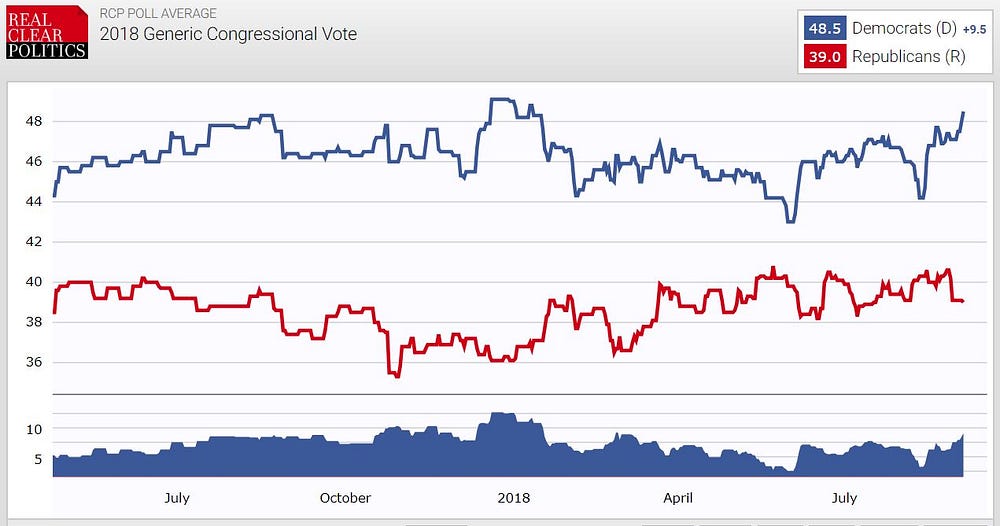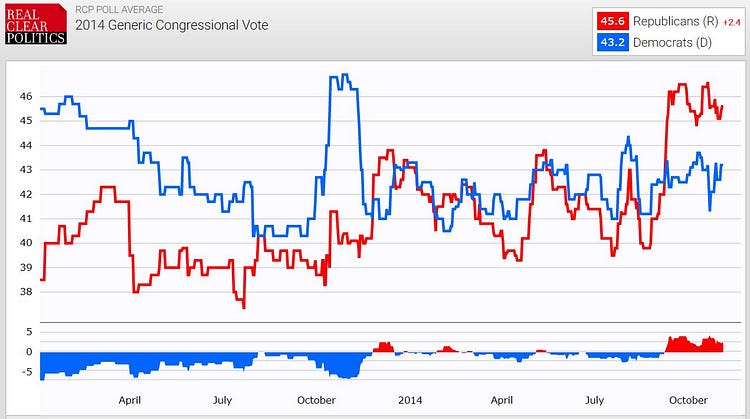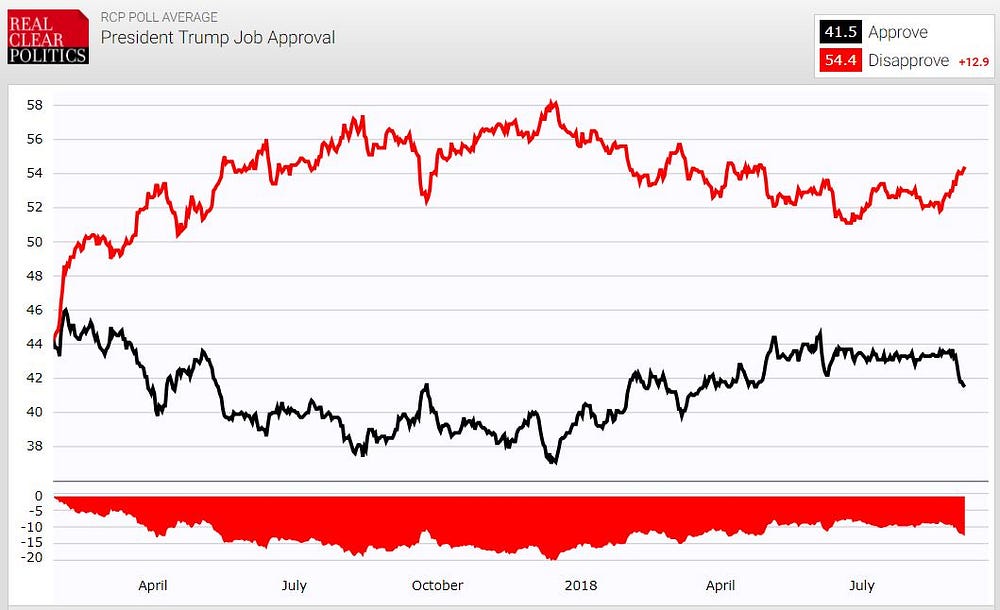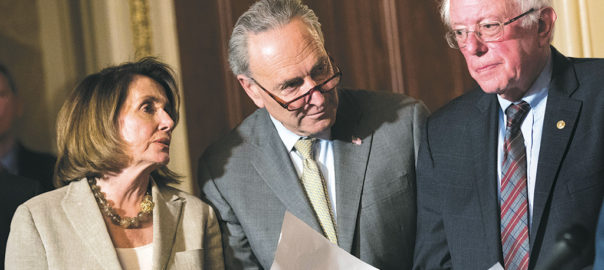By Kent R. Kroeger (September 6, 2018)
It’s over.
While we still have to suffer through the general election kabuki dance, there is no mystery as to which party will control the U.S. House after the 2018 midterm elections. According to NuQum.com’s prediction model (see Figure 1) for the 2018 midterm election, the GOP will lose 35 House seats (Democrats need 23 to regain control of the House) and 4 Senate seats.
Despite far more Democratic incumbents running in the 2018 U.S. Senate contests, the NuQum.com model predicts the Democrats will regain control of the U.S. Senate.
Figure 1. Midterm Congressional Election Predictions

The NuQum.com U.S. House prediction model relies on five variables to predict the number of House seats lost/gained by the two parties: Presidential job approval (Gallup), Pct. Change in Real Disposable Personal Income, Size of Current Party’s Majority, Majority Party’s Performance in Previous Midterm Election, Indicator for Lame Duck Presidency. The U.S. Senate model uses only three variables: Presidential job approval (Gallup), Pct. Change in Real Disposable Personal Income, and an Indicator for a Lame Duck Presidency. Data and model specifications are available upon request to: kroeger98@yahoo.com
Why is the midterm elections outcome irreversible?
Labor Day is considered by many political analysts the key inflection point for midterm elections. Any party with a large lead in the generic ballot at that point is going to do well on Election Day. Given the current numbers, it would be unprecedented if the GOP were to retain control of the U.S. House after the midterms.
Figure 2. 2018 Generic Congressional Vote

Since the wide use of the generic congressional ballot question for tracking purposes, such a turnaround has never happened this late in a midterm election year. The last two midterms are illustrative of this stability and the practical irrelevance of general election campaigns (see Figure 2).
Figure 3. Generic Congressional Ballot in 2014 & 2010 Midterm Elections


The party that significantly leads the generic ballot in early September will most likely win the majority of votes in November. Scandals, candidate gaffes and other unpredictable events occurring late in the general election can alter individual race outcomes, but those cases tend to be randomly distributed and never sufficient in numbers to change the aggregate outcome for the Democrats and Republicans.
The Democrats will gain 35 House seats and 4 Senate seats in November and there is nothing Donald Trump and the Republicans can do to alter this eventuality. According to the NuQum.com model, Trump’s job approval could surge to 50 percent approval (it won’t) and the Republicans would still lose 26 House seats and one Senate seat.
Understandably, memories of the 2016 election give Democrats pause about making strong predictions regarding 2018, but congressional elections in general are more predictable than presidential outcomes. In a bad year for incumbents, such as 2010 when the Democrats lost 52 House seats, 85 percent still won re-election. Retirements and open seat contests introduce some competitiveness into congressional elections; but, generally, those contests tend to break towards the party with the momentum heading into the general election. That party is the Democrats this year.
Despite the considerable effort The Cook Report and Larry Sabato’s Crystal Ball put into predicting each congressional race, they are just modeling idiosyncratic variation. While their predictions are interesting, their analytic efforts merely nibble at the margins and are wholly unnecessary. The net partisan outcome for the 2018 midterms was largely determined in late 2017 when candidates had to make a decision whether or not to run for office.
Figure 4. Trump Job Approval

A quick inspection of Figure 4 shows Trump’s job approval in late 2017 was at or near the bottom for his term. In other words, quality Democratic candidates should have been feeling at that time very confident in their candidacies being successful in 2018. The NuQum.com model at the start of 2018 predicted a net House gain by Democrats of around 40 seats. Little has changed since that prediction.
The Democrats are putting high-quality candidates up against vulnerable Republicans
The New York Times’ Frank Bruni and Liriel Higa recently highlighted the 13 congressional candidates they consider the “faces” of the next generation of Democratic leaders. Despite relying on a lazy and predicable ‘year of the woman’ narrative, their article conveyed the considerable strengths of the newest generation of first-time Democratic congressional candidates.
The candidates in the article share this common trait: Good speakers that prefer to emphasize their background and résumés over talking about specific policy ideas. It’s a safe strategy geared towards getting centrist Democrats elected in conservative-leaning congressional districts.
The following video clips are indicative of the high quality found among the candidates mentioned in the Bruni and Higa article:
Chrissy Houlahan (PA-6)
Katie Hill (CA-25)
Lauren Underwood (IL-14)
Elissa Slotkin (MI-8)
Max Rose (NY-11)
Mikie Sherrill (NJ-11)
M.J. Hegar (TX-31)
Ammar Campa-Najjar (CA-50)*
Colin Allred (TX-32)*
Leslie Cockburn (VA-5)
Kathy Manning (NC-13)
Andy Kim (NJ-3)
Xochitl Torres Small (NM-2)
* Indicates Justice Democrat (progressive)
These are strong, high-quality Democratic challengers who saw President Trump’s significant weaknesses with voters in late 2017, particularly in suburban America, and realized now is their opportunity to run and win. That fact, more than any other reason, is why the outcome of the 2018 midterms is already baked into the system. At this late juncture, there is nothing the Republicans can do to save their House majority, and they will probably lose the Senate majority as well.
The 2018 midterm elections are, for all intents and purposes, over. Election Day in November is a mere formality.
Now the bad news for Democrats…
Unwittingly, Bruni and Higa also brought into focus a dangerous split that increasingly defines today’s Democratic Party. For lack of a better description, the split is between the Democratic Party establishment, still personified by Barack Obama, and the party’s progressive wing, otherwise known as Berniecrats.
According to Bruni and Higa, to win in traditionally Republican and suburban congressional districts, the Democrats are relying largely on centrist Democrats (or policy averse Democrats, as I call them) who emphasize their identities and personal backgrounds over their specific policy ideas.
Among the candidates Bruni and Higa feature, most are women, many have military service in their background and, with some noticeable exceptions, avoid policy specifics. Yes, these candidates have policy preferences, but that is not how they want to define themselves with voters. Similar to the Hillary Clinton campaign, the emphasis is on résumé over substance. Only Allred and Campa-Najjar from the Bruni and Higa article can be considered strong progressives.
A good example of these centrist candidates is Katie Hill, the Democratic House candidate in California’s 25th district, who is bisexual, married to a bisexual man, had an unplanned pregnancy at 18 and owns guns. These specific traits, experiences and life choices really have nothing to do with one another, other than they emphasize her distinctiveness from the Republican incumbent, Steve Knight, who has routinely voted to limit reproductive rights and deny basic civil liberties to LGBTQ Americans. More importantly, Hill is decidedly centrist in her policy views, even though she is routinely called a ‘progressive’ by the national news media.
In describing the Hill candidacy, The Los Angeles Times asks: How does a progressive Democrat try to unseat a Republican? Step one: Don’t talk about single-payer healthcare.
During a chat with a liberal activist group about universal health care, Hill said, “I shouldn’t go into the district and talk about single-payer, right? Like, that word by itself is going to be something that just immediately turns off a lot of people. But, if I talk about how we need to make sure that everybody has access to healthcare and that it’s affordable for everybody and how having a government option is needed at the very least, that is something people can really get behind. It’s more about the way we talk about things than being very far apart on issues.”
Hill’s answer is straight out of the corporatist ‘New Democrat’ handbook: When addressing universal health care, load your sentences with inoffensive platitudes and commit to nothing. This is not a criticism of Hill. To the contrary, it demonstrates her readiness to run for office and win. It is that quality in her that separates high-quality candidates that can win from political neophytes, who usually go down in a flaming heap of position papers and policy statements when they first run for office.
Hill is simply implementing the ‘New Democrat’ strategy championed by Bill Clinton and Al Gore in post-Reagan America and perfected by Barack Obama. Strategic centrism, as Illinois Senator Tammy Duckworth describes it, advises Democrats to stay as close to the political center as possible, without alienating the progressive wing of the party; and, when at all possible, avoid boxing themselves in with firm positions on major policy proposals when, instead, they must put a premium on ideological flexibility.
It is this strategy that has become the dominant approach among today’s establishment Democrats, particularly those competing in middle America and conservative-leaning, suburban districts.
When Alexandria Ocasio-Cortez defeated incumbent Democrat Joe Crowley in New York’s 14th House District primary, Duckworth told CNN’s Jake Tapper that Ocasio-Cortez is not necessarily a model for other Democrats to follow. She is only “the future of the party in the Bronx, where she is,” said Duckworth. “I don’t think that you can go too far to the left and still win the Midwest.”
Duckworth may be right, but her opinion, which reflects the views of most establishment Democrats, is oddly reminiscent of an argument establishment Republicans were making in the mid-1970s when they dismissed Ronald Reagan’s muscular conservatism as a viable national strategy. Like Duckworth, the Bob Doles and Nelson Rockefellers in the GOP at the time saw overly strident ideological positions as a liability, not a strategic asset.
They were wrong and Reagan conservatism has been the establishment position for the GOP up until Trump’s recent rise.
And today’s Democratic Party looks increasingly like the Republican Party when it emerged from under Richard Nixon and Watergate — no coherent vision, just a need to regain power any way possible.
The 2018 midterms may be 1978 all over again
Democratic leaders insist on using the same playbook as Bill Clinton’s in 1992 or Barack Obama’s in 2008: Stay near the political center and rely on organizational superiority and candidate charisma to win elections. Substantive policy fights are best held away from the public’s gaze.
But what will happen once the Democrats, riding on the success of its centrist candidates, take back control of the House and Senate next January? Do the Democratic progressives who will join them, such as New York’s Ocasio-Cortez, Michigan’s Rashida Tlaib, and Massachusetts’ Ayanna Pressley, simply take a backbench seat and wait for their marching orders from House Speaker Nancy Pelosi? I don’t think so. In fact, conditions will likely deteriorate very fast for the Democrats, especially if they also control the U.S. Senate.
Ocasio-Cortez isn’t going to Congress to watch Pelosi and New York Senator Chuck Schumer run investigations on the Trump administration. Her constituents will want to see tangible results. Sadly, they will far more likely see the Democrat-controlled Congress approve record-sized defense budgets than the passage of legislation overhauling the inefficient U.S. health care system or increasing the minimum wage or reducing the student debt burden for millions of Americans.
Can Pelosi and Schumer maintain the delicate balance between the corporatist interests seeking open markets, capital mobility, and low labor costs and progressive Democrats, many of whom are still fuming over how the Democratic National Committee openly rigged 2016 primary process against Bernie Sanders? It’s a balancing act the Democratic Party establishment has been attempting since 1992, with little success. Why should the present be any different?
Still, establishment Democrats will see the 2018 landslide as a watershed moment in U.S. political history where a near-permanent Democratic majority finally emerges. The GOP’s impending electoral debacle will, in turn, be seen as a signal of the end of its dominance over the American political system since 1978, when the first sizable number of Reagan conservatives began to win elections.
As it always is, the reality for Democrats will be murkier and fraught with political landmines. The 2018 midterms will be the first election when a meaningful number of progressive, anti-establishment Democrats start winning elections.
However, if progressives are rebuffed and ignored by their congressional leadership (as I expect they will be), they will unleash hellfire on their leaders, not unlike the backbencher revolt Newt Gingrich engineered against his party’s establishment in the late 80s and early 90s. Furthermore, it is increasingly possible the Democratic Party will effectively split into two separate parties, aligned on social justice issues, but permanently divided on economic policy.
If the 2016 election taught us anything, it is that majority of voters across the ideological spectrum are tired of establishment politicians dedicated to the interests of their large campaign donors over the interests of most Americans. As filmmaker Michael Moore aptly put it, Trump was their Molotov cocktail being thrown into the political system.
The message should have been obvious to the political establishment in both parties. Instead, we are distracted by various forms of Trump Derangement Syndrome and anti-Russia scaremongering every night on our nightly news programs.
The American political class has done nothing to regain the trust of the American people. Nothing.
As I pour through reams of survey cross-tabulations on current American attitudes, two years removed from the 2016 election, I see the same distrust and anger that was evident then— in fact, the discontent directed towards the political system may be worse (see Figure 5 below). And while most Americans are done with Trump, they are not screaming for more cautious centrism in his place. And does anyone think Nancy Pelosi and Chuck Schumer are the leadership Americans are craving for?
Figure 5. Trust in the Federal Government is Near All-time Lows

It is informative that Bernie Sanders is still among the most popular politicians in America today. According to YouGov’s popularity tracking service, as of July 2018, Bernie Sanders was the 14th most popular person in the U.S., behind other politicians and notables such as Joe Biden (13th), Pope Francis (11th), Jimmy Carter (10th), Barack Obama (5th), Prince William (4th), Prince Harry (3rd), Bill Gates (2nd) and Queen Elizabeth (1st).
Behind Sanders are Bill Clinton (20th), Hillary Clinton (28th), Donald Trump (29th), Elizabeth Warren (41st), Nikki Haley (64th), Nancy Pelosi (67th), Chuck Schumer (78th), Corey Booker (82nd), Kamala Harris (88th) and Kristen Gillibrand (117th).
Seeing the continued strength of the Sanders brand relative to other active Democratic politicians, I wonder if the Democratic Party learned what it should have from 2016?
We will find out soon enough.
-K.R.K.
About the Author: Mr. Kroeger is a survey and statistical consultant with over 30 -years experience measuring and analyzing public opinion. He currently lives in New Jersey with his wife and son (You can contact him at: info@olsonkroeger.com)
